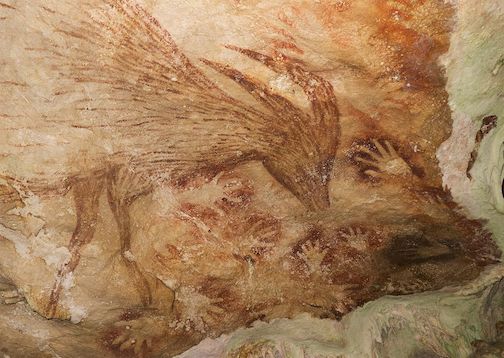 Cave Paintings in Indonesia Redraw Picture of Earliest Art
Cave Paintings in Indonesia Redraw Picture of Earliest Art
The dating discovery recasts ancient cave art as a continent-spanning human practice.
Dan Vergano
National Geographic
PUBLISHED OCTOBER 8, 2014
A hand painted in an Indonesian cave dates to at least 39,900 years ago, making it among the oldest such images in the world, archaeologists reported Wednesday in a study that rewrites the history of art.
The discovery on the island of Sulawesi vastly expands the geography of the first cave artists, who were long thought to have appeared in prehistoric Europe around that time. Reported in the journal Nature, the cave art includes stencils of hands and a painting of a babirusa, or "pig-deer," which may be the world's oldest figurative art.
"Overwhelmingly depicted in Europe and Sulawesi were large, and often dangerous, mammal species that possibly played major roles in the belief systems of these people," says archaeologist and study leader Maxime Aubert of Griffith University in Queensland, Australia.
The finds from the Maros cave sites on Sulawesi raise the possibility that such art predates the exodus of modern humans from Africa 60,000 or more years ago.
"I predict that even older examples of cave art will be discovered on Sulawesi, and in mainland Asia, and ultimately in our African homeland," says human origins expert Chris Stringer of the Natural History Museum in London, who was not on the study team.
Uranium traces reveal the earliest possible dates for a hand stencil and female babirusa (a hoglike animal also called a pig-deer) painted in Sulawesi's Leang Timpuseng cave.
Oldest Art
Since the 1950s, scholars have reported hundreds of hand stencils and images of animals in caves on Sulawesi, which were assumed prehistoric but thought to be no more than 12,000 years old, dating to a hunter-gatherer migration to the island.
In the new study, the researchers investigated mineral layers less than 0.4 inches (10 millimeters) thick covering images in seven caves, and in some cases sandwiching them. Trace amounts of radioactive uranium in these mineral layers reveal when water carried the minerals over the cave wall. Finding the ages of these deposits narrows down the time when the images were painted.
The age discovered for the oldest hand stencil in the cave—39,900 years old—is therefore merely the minimum age of the minerals coating the image, meaning the art could be thousands of years older.
A red disk painted in Spain's El Castillo cave is at least 40,800 years old according to the same dating method, making it the oldest known cave art, and a hand stencil there is 37,300 years old. The Sulawesi cave paintings rival these finds in age and appear to belong to a tradition that persisted there as recently as 17,000 years ago.
"We've been shown here that our views have been too 'Euro-centric' about the origins of cave painting," says archaeologist Alistair Pike of the University of Southampton in the United Kingdom. "Absolutely this changes our views, and is going to make us ask a lot of questions about the causes rather than the origins of cave art."
Out of Africa?
In 1880, prehistoric paintings found inside Spain's cave of Altamira galvanized experts and began the study of cave paintings. Hundreds more such sites have turned up in Europe in the past century.
As site after site was found in Europe, the view emerged that modern people must have arrived there from Africa and undergone a cultural shift as they competed with Neanderthals for prey and for caves.
Instead, the newly discovered cave painting suggests that art may have been universal among early modern people, including those who left Africa and traveled across southern Arabia to Indonesia and Australia within the past 50,000 years.
Cave art may have left Africa with early modern humans, the study authors suggest, or possibly it sprang up independently among different groups. The earliest examples of other kinds of art are even older, such as decorative perforated shell beads and pigments that date to more than 75,000 years ago.
"Certainly making hand stencils seems a universal human practice," Pike says. Hands are seen in caves and archaeological sites worldwide, even one in Argentina dating to 9,000 years ago. "Children love to make handprints, even today."
Or art may have served as a kind of social glue. Modern humans migrating out of Africa and facing new habitats, predators, and competition might have needed to travel in larger groups, spurring a need for art as part of the cultural fabric. "One way to display rituals and symbols is with cave art," he says.
